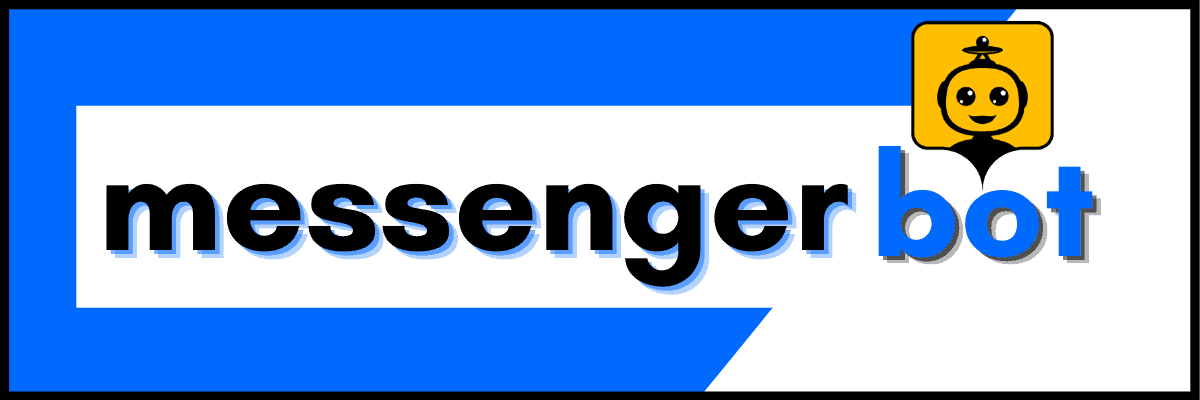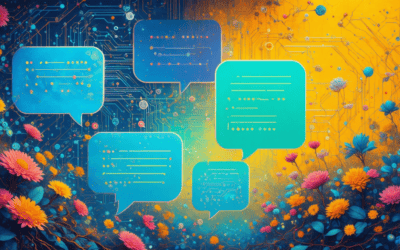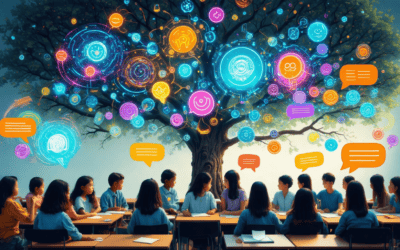In today’s digital landscape, the power of custom chatbots is revolutionizing how businesses interact with their customers. As AI technology advances, creating your own chatbot has become more accessible than ever, offering a unique opportunity to enhance customer engagement and streamline operations. This comprehensive guide will walk you through the process of building a custom chatbot, from understanding the basics to implementing advanced SEO techniques for optimal performance. Whether you’re looking to explore free AI chatbot options, tailor ChatGPT to your specific needs, or develop a personal AI assistant, we’ll cover everything you need to know to create an AI-powered conversation tool that stands out in search engine results and delivers value to your audience.
Understanding Custom Chatbots
Custom chatbots are revolutionizing the way businesses interact with their customers, offering personalized and efficient communication solutions. As an AI-driven platform, we at Messenger Bot understand the importance of tailoring chatbots to meet specific business needs. Custom AI chatbots are designed to reflect your brand’s voice, handle complex queries, and provide a seamless user experience across various channels.
How do I create my own chatbot?
Creating your own chatbot has never been easier, thanks to advanced SEO and Natural Language Processing (NLP) techniques. Here’s a step-by-step guide to help you get started:
1. Define your chatbot’s purpose and goals
2. Choose a suitable platform (like Messenger Bot)
3. Design your chatbot’s conversation flow
4. Develop and integrate your chatbot’s knowledge base
5. Train your AI using relevant data and user interactions
6. Test thoroughly for accuracy and user experience
7. Deploy and monitor your chatbot’s performance
By following these steps, you can create a chatbot that not only serves your business needs but also ranks well in search engine results pages. Remember, the key to a successful chatbot lies in its ability to understand and respond to user queries effectively while maintaining engagement levels.
Benefits of custom AI chatbots for businesses
Implementing custom AI chatbots can provide numerous advantages for businesses across various industries. Here are some key benefits:
• 24/7 Availability: Custom chatbots offer round-the-clock customer support, ensuring that your business is always accessible to customers.
• Cost-Efficiency: By automating routine tasks and inquiries, chatbots can significantly reduce operational costs associated with customer service.
• Scalability: As your business grows, chatbots can easily handle an increasing volume of customer interactions without the need for proportional staffing increases.
• Personalized Experiences: Advanced AI and NLP allow chatbots to provide tailored responses based on user preferences and historical data.
• Data Collection and Analysis: Chatbots can gather valuable insights from customer interactions, helping businesses make data-driven decisions.
• Improved Customer Satisfaction: Quick and accurate responses lead to higher customer satisfaction rates and improved brand loyalty.
By leveraging these benefits, businesses can enhance their customer service capabilities while optimizing their resources. Platforms like Brain Pod AI offer sophisticated AI solutions that can be customized to meet specific business requirements, further enhancing the potential of custom chatbots.

Exploring Free AI Chatbot Options
As businesses seek to enhance customer engagement and streamline operations, the demand for AI chatbots has skyrocketed. While custom AI chatbots offer tailored solutions, many companies are exploring free options to get started. Let’s dive into the world of free AI chatbots and compare some popular platforms.
Is there a free AI chatbot?
Yes, there are several free AI chatbot options available for businesses and individuals looking to implement conversational AI without initial investment. These free chatbots can be excellent starting points for those new to chatbot technology or for small businesses with limited resources.
At Messenger Bot, we understand the importance of accessibility in AI technology. While we offer advanced paid features, we also provide a free trial that allows users to experience the power of our AI-driven chatbot platform before committing to a subscription.
Some popular free AI chatbot platforms include:
- Dialogflow by Google: Offers a free tier with basic natural language processing capabilities.
- MobileMonkey: Provides a free plan with limited features for Facebook Messenger bots.
- Chatfuel: Offers a free plan for up to 50 users, ideal for small businesses or startups.
- Brain Pod AI: While primarily known for their advanced AI services, they also offer some free tools to get started with AI chatbots.
It’s important to note that while these platforms offer free options, they often come with limitations in terms of features, customization, or the number of interactions. As your needs grow, you may find it necessary to upgrade to a paid plan or switch to a more robust solution like Messenger Bot for advanced SEO-focused chatbot capabilities.
Comparing popular free chatbot platforms
When evaluating free AI chatbot options, it’s crucial to consider factors such as ease of use, customization capabilities, and integration options. Here’s a comparison of some popular free chatbot platforms:
- Dialogflow:
- Pros: Powerful natural language processing, integrates well with Google services
- Cons: Can be complex for beginners, limited features in the free tier
- MobileMonkey:
- Pros: User-friendly interface, specifically designed for Facebook Messenger
- Cons: Limited to Facebook platform, restricted features in the free plan
- Chatfuel:
- Pros: Easy to use, no coding required, good for Facebook Messenger bots
- Cons: Limited to 50 users in the free plan, less advanced NLP capabilities
- Messenger Bot:
- Pros: Advanced SEO optimization, multilingual support, and integration with various platforms
- Cons: Full features available in paid plans, free trial has time limitations
While free chatbot platforms can be a great starting point, businesses looking for more advanced features, better SEO optimization, and scalability often find that investing in a comprehensive solution like Messenger Bot pays off in the long run. Our platform offers advanced AI-driven chatbot capabilities that can significantly enhance customer engagement and drive better search engine rankings.
As you explore these options, consider your long-term goals and the potential for growth. While free options can help you get started, a more robust solution may be necessary to fully leverage the power of AI chatbots for your business.
III. Customization Capabilities
At Messenger Bot, we understand the importance of tailoring your chatbot to fit your unique business needs. Our custom AI chatbot platform offers extensive customization options, allowing you to create a personalized virtual assistant that aligns perfectly with your brand voice and customer service goals.
A. Can chatbot be customized?
Absolutely! Customization is at the heart of what we offer. Our advanced SEO-focused platform enables you to fine-tune every aspect of your chatbot, from its appearance to its responses. You can easily adjust the chatbot’s personality, language, and knowledge base to create a seamless extension of your brand.
With our user-friendly interface, you can customize your chatbot’s features without any coding knowledge. This includes setting up specific conversation flows, creating custom intents, and integrating with your existing systems for a truly tailored experience.
For businesses looking to leverage cutting-edge Natural Language Processing (NLP) techniques, our platform incorporates state-of-the-art algorithms that enable your chatbot to understand context and nuance, resulting in more human-like interactions. This level of customization ensures that your chatbot can handle complex queries and provide accurate, relevant responses, ultimately improving user engagement and satisfaction.
B. Advanced SEO techniques for chatbot responses
Optimizing your chatbot for search engines is crucial for maximizing its visibility and effectiveness. At Messenger Bot, we’ve integrated advanced SEO techniques directly into our chatbot customization process, helping you boost your rankings on search engine results pages.
One key strategy we employ is the strategic use of cluster keywords and relevant terms within your chatbot’s responses. This helps search engines understand the context and relevance of your content, potentially improving your website’s overall SEO performance.
We also focus on optimizing your chatbot’s responses for featured snippets and voice search. By structuring answers in a concise, informative manner, we increase the chances of your content appearing in these prominent positions, driving more organic traffic to your site.
Additionally, our platform allows you to create dynamic, SEO-friendly URLs for specific chatbot conversations. This feature can significantly enhance your site’s internal linking structure, a crucial factor in SEO rankings.
To further boost your SEO efforts, we recommend integrating your chatbot with Brain Pod AI’s AI Writer. This powerful tool can help generate SEO-optimized content for your chatbot, ensuring that every interaction contributes to your overall search engine visibility.
By combining these advanced SEO techniques with our customizable chatbot platform, you’ll be well-equipped to create a powerful, search-engine-friendly virtual assistant that drives engagement and boosts your online presence.
IV. Tailoring ChatGPT to Your Needs
At Messenger Bot, we understand the importance of customization when it comes to AI chatbots. ChatGPT, developed by OpenAI, has revolutionized the way we interact with artificial intelligence. However, many users wonder if they can tailor this powerful tool to meet their specific requirements. Let’s explore the possibilities of customizing ChatGPT and how it can enhance your engagement strategies.
A. Can I customize ChatGPT?
The short answer is yes, you can customize ChatGPT to a certain extent. While the core model remains the same, there are several ways to tailor its output to better suit your needs:
1. Fine-tuning: This advanced SEO technique involves training the model on a specific dataset relevant to your industry or use case. By doing so, you can improve the chatbot’s performance in specialized domains.
2. Prompt engineering: Crafting well-designed prompts can guide ChatGPT to produce more targeted and relevant responses. This method is crucial for optimizing chatbot content for search engine rankings.
3. API integration: For developers, OpenAI’s API allows for deeper customization, enabling the integration of ChatGPT into existing systems and applications.
4. Custom instructions: Some platforms, like Messenger Bot, offer the ability to set custom instructions or rules for the AI, allowing for a more tailored interaction experience.
B. Leveraging Custom GPT chatbot for enhanced engagement
Creating a custom GPT chatbot can significantly boost user engagement and improve your SEO rankings. Here’s how you can leverage this technology:
1. Personalized interactions: By incorporating user data and preferences, your custom chatbot can provide more relevant and engaging responses, increasing user satisfaction and time spent on your site.
2. Multilingual support: Implement Natural Language Processing (NLP) techniques to enable your chatbot to communicate in multiple languages, expanding your global reach and improving search visibility in different regions.
3. Content generation: Use your custom GPT chatbot as an article writer to create SEO-focused, general yet impactful content that incorporates strategic cluster keywords and relevant terms.
4. FAQ automation: Develop a comprehensive FAQ section powered by your custom chatbot, addressing common queries and potentially capturing featured snippets in search engine results pages (SERPs).
5. Voice search optimization: Train your chatbot to understand and respond to voice queries, aligning with the growing trend of voice search and potentially improving your rankings for voice-based searches.
By tailoring ChatGPT to your specific needs, you can create a powerful tool that not only enhances user experience but also boosts your SEO efforts. At Messenger Bot, we offer advanced customization options to help you create a chatbot that aligns perfectly with your brand and business objectives.
Remember, the key to success lies in striking the right balance between customization and maintaining the natural flow of conversation. By following SEO best practices and focusing on providing value to your users, you can create a custom GPT chatbot that drives engagement levels and improves your search engine visibility.

V. Developing a Custom Chatbot for Your Data
As businesses strive to leverage advanced SEO techniques and enhance customer engagement, developing a custom chatbot tailored to your specific data has become increasingly crucial. At Messenger Bot, we understand the importance of integrating proprietary information into your chatbot to create a truly unique and valuable user experience.
Custom AI chatbots offer a powerful way to interact with your audience while showcasing your brand’s expertise. By incorporating your own data, you can create a chatbot that not only answers general queries but also provides insights specific to your industry and company. This level of customization can significantly improve your SEO rankings and user engagement levels.
A. Integrating proprietary information into your chatbot
Integrating your proprietary information into a custom chatbot requires careful planning and execution. Here are some key steps to consider:
- Data Collection and Organization: Gather all relevant data, including product information, FAQs, and company policies. Organize this information in a structured format that can be easily accessed by your chatbot.
- Natural Language Processing (NLP) Training: Utilize advanced NLP techniques to train your chatbot to understand and respond to user queries using your specific data. This process involves feeding your chatbot with examples of how users might phrase questions related to your business.
- Continuous Learning: Implement machine learning algorithms that allow your chatbot to improve its responses over time based on user interactions. This ensures that your chatbot remains up-to-date and increasingly accurate.
- Integration with Existing Systems: Connect your chatbot to your CRM, knowledge base, or other internal systems to provide real-time, accurate information to users.
By following these steps, you can create a chatbot that serves as a valuable extension of your brand, providing personalized and accurate responses to user queries. This level of customization not only enhances user experience but also contributes to improved SEO performance by increasing engagement and time spent on your site.
B. Ensuring data security and privacy in custom chatbots
While integrating proprietary information into your chatbot can greatly enhance its functionality, it’s crucial to prioritize data security and privacy. Here are some best practices to ensure the protection of sensitive information:
- Encryption: Implement strong encryption protocols to protect data both in transit and at rest. This includes using HTTPS for all communications between the user and the chatbot.
- Access Control: Establish strict access controls to limit who can view or modify the chatbot’s underlying data and algorithms. This helps prevent unauthorized access to sensitive information.
- Data Minimization: Only collect and store the minimum amount of user data necessary for the chatbot to function effectively. This reduces the risk of data breaches and complies with data protection regulations.
- Regular Security Audits: Conduct regular security audits and penetration testing to identify and address potential vulnerabilities in your chatbot system.
- Compliance with Regulations: Ensure that your chatbot complies with relevant data protection regulations such as GDPR or CCPA, depending on your target audience and location.
At Messenger Bot, we take data security seriously and incorporate these best practices into our custom chatbot solutions. By prioritizing both functionality and security, you can create a chatbot that not only enhances user engagement but also builds trust with your audience.
For businesses looking to explore advanced chatbot solutions, Brain Pod AI offers a range of AI-powered tools, including customizable chatbots that can be tailored to specific business needs while maintaining high standards of data security.
By developing a custom chatbot that integrates your proprietary data securely, you can create a powerful tool that enhances customer interactions, improves SEO performance, and sets your brand apart in the digital landscape. Remember, the key to success lies in striking the right balance between personalization and privacy, ensuring that your chatbot provides value while maintaining the trust of your users.
VI. Creating a Personal AI Assistant
In today’s digital landscape, personal AI assistants have become increasingly popular, offering tailored support and enhancing productivity. As a leader in chatbot technology, I’ve seen firsthand how custom AI assistants can revolutionize daily tasks and interactions. Let’s explore how you can create your own AI chatbot that reflects your personality and meets your specific needs.
A. Make an AI chatbot of yourself: Steps and considerations
Creating a personal AI chatbot involves several key steps:
1. Define your chatbot’s purpose: Determine what tasks you want your AI assistant to perform, such as scheduling, answering questions, or providing reminders.
2. Choose a platform: Select a chatbot development platform that offers customization options and aligns with your technical skills. Our platform at Messenger Bot provides an intuitive interface for creating personalized AI assistants.
3. Gather personal data: Compile information about yourself, including your speech patterns, knowledge base, and decision-making processes. This data will help create a more authentic representation of you.
4. Train your AI model: Use Natural Language Processing (NLP) techniques to train your chatbot on your personal data. This step is crucial for developing a chatbot that can mimic your communication style and thought processes.
5. Implement personality traits: Incorporate your unique characteristics, such as humor, empathy, or problem-solving approaches, to make the chatbot truly representative of you.
6. Test and refine: Continuously interact with your chatbot and gather feedback from others to improve its responses and functionality.
7. Ensure privacy and security: Implement robust security measures to protect the personal data used to create and train your AI chatbot.
When creating a personal AI chatbot, it’s essential to consider ethical implications and potential limitations. While AI can mimic human-like interactions, it’s important to maintain transparency about its artificial nature.
B. Implementing Natural Language Processing for human-like interactions
Natural Language Processing (NLP) is the cornerstone of creating human-like interactions in AI chatbots. By leveraging advanced SEO techniques and NLP, we can develop chatbots that understand and respond to user queries with remarkable accuracy and naturalness.
Key aspects of implementing NLP in your personal AI assistant include:
1. Intent recognition: Train your chatbot to accurately identify the user’s intention behind each query, allowing for more precise and relevant responses.
2. Entity extraction: Enable your AI to recognize and extract important information from user inputs, such as names, dates, or locations.
3. Sentiment analysis: Implement algorithms that can detect and respond appropriately to the emotional tone of user messages, enhancing the chatbot’s empathy and relatability.
4. Context management: Develop your chatbot’s ability to maintain context throughout a conversation, creating more coherent and meaningful interactions.
5. Language generation: Utilize advanced language models, such as those offered by Brain Pod AI, to generate human-like responses that match your personal communication style.
6. Continuous learning: Implement machine learning algorithms that allow your chatbot to improve its understanding and responses over time based on user interactions.
7. Multilingual support: If you’re multilingual, consider integrating multilingual capabilities to make your personal AI assistant more versatile and accessible to a broader audience.
By focusing on these NLP techniques, you can create a personal AI assistant that not only understands and responds to queries effectively but also engages in conversations that feel natural and personalized. This level of sophistication in AI interactions can significantly enhance user engagement and satisfaction, ultimately contributing to improved SEO rankings for your chatbot-related content.
Remember, the key to creating a successful personal AI assistant lies in striking the right balance between technological advancement and maintaining your unique personal touch. As you develop your chatbot, continually refine its responses and capabilities to ensure it remains an accurate and helpful digital representation of yourself.
VII. Optimizing Your Custom Chatbot
At Messenger Bot, we understand the importance of optimizing your custom chatbot to ensure it performs at its best. By implementing advanced SEO techniques and leveraging Natural Language Processing (NLP), we can help your chatbot rank higher in search engine results pages and provide more value to your users.
A. SEO best practices for chatbot content
To optimize your custom chatbot for search engines, consider these SEO-focused strategies:
1. Keyword Research: Conduct thorough keyword research to identify relevant terms and phrases your target audience is searching for. Incorporate these strategic cluster keywords naturally into your chatbot’s responses.
2. Content Quality: Ensure your chatbot provides valuable, informative content that addresses user queries effectively. High-quality, engaging content is more likely to rank well in search results.
3. Mobile Optimization: With the increasing use of mobile devices, it’s crucial to optimize your chatbot for mobile users. This includes fast loading times and responsive design.
4. Voice Search Optimization: As voice search becomes more prevalent, optimize your chatbot’s responses for natural language queries. This can help improve your chances of appearing in voice search results.
5. Structured Data: Implement structured data markup to help search engines better understand your chatbot’s content and functionality.
6. Internal Linking: Incorporate relevant internal links within your chatbot’s responses to guide users to additional information on your website.
B. Measuring and improving chatbot performance for better search engine rankings
To continually enhance your custom chatbot’s performance and search engine rankings, consider these strategies:
1. Analytics Integration: Implement robust analytics tools to track key performance indicators (KPIs) such as user engagement levels, conversation duration, and successful query resolutions.
2. A/B Testing: Conduct regular A/B tests on your chatbot’s responses to identify which versions perform better in terms of user satisfaction and search engine visibility.
3. User Feedback Analysis: Regularly analyze user feedback to identify areas for improvement and refine your chatbot’s responses accordingly.
4. Continuous Learning: Leverage AI and machine learning capabilities to continuously improve your chatbot’s understanding and responses based on user interactions.
5. Content Updates: Regularly update your chatbot’s knowledge base with fresh, relevant content to maintain its search engine rankings and provide up-to-date information to users.
6. Performance Monitoring: Use tools like Google Search Console to monitor your chatbot’s performance in search results and identify opportunities for improvement.
7. Competitor Analysis: Keep an eye on your competitors’ chatbot strategies and search engine rankings to stay ahead in the market.
By implementing these SEO best practices and performance improvement strategies, you can optimize your custom chatbot to deliver exceptional user experiences while boosting its visibility in search engine results. At Messenger Bot, we’re committed to helping you create a high-performing, SEO-friendly chatbot that drives engagement and delivers results for your business.
For those looking to explore additional AI-powered tools, Brain Pod AI offers a comprehensive suite of AI solutions, including an advanced AI writer and image generator, which can complement your chatbot strategy and further enhance your digital presence.




